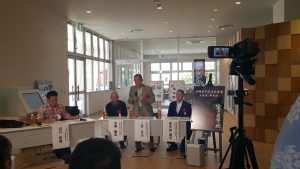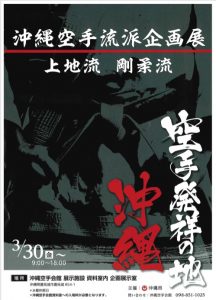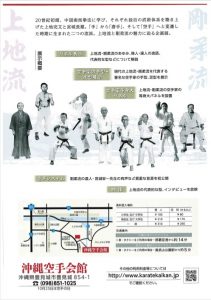New special exhibition special talk-show
March 30th, a new special exhibition was opened to the public at the Okinawa Karate Kaikan. To commemorate the opening, a special talk-show sponsored by the prefectural Karate Promotion Division was held.
The speakers were Uechi-ryū Tomoyose Ryūkō and Uehara Takenobu as well as Gōjū-ryū Higaonna Morio. The three masters are Okinawa Prefecture designated intangible cultural asset holders. The talk-show was coordinated by Yamakawa Tetsuo, head of the Prefecture’s Karate Promotion Division. More than 60 people attended the event.
90 years old Tomoyose sensei was the first to address the audience. Born in Motobu town in the northern part of Okinawa’s main island, he later enrolled in Icchu (1). The first 2 years, he was able to study regularly but the third year, with the war advancing, he was more involved with military works than with school activities. On March 23 of 1945, he travelled all the way to Nakijin village in order to get a seal from his parents allowing him to join the Kinnō Tai (2). The fact that he was not able to return to the southern part of the main island saved his life.
After telling episodes of his youth, he recalled with much humor stories when teaching karate in the United States, ending his address saying, “Without karate I wouldn’t have had such experiences.”
Next, Uehara sensei (88) talked about the past and recalled the teachings of his father and teacher, Uehara Saburō sensei. “Karate is a mean to eliminate likes and dislikes. Karate, which is a fight with oneself, aims at polishing oneself and train the spirit”. He added, “When one gets stuck, returning to the breathing of Sanshin kata will open the path”.
In addition, Uehara sensei introduced the project of the bronze statue of Uechi Kanbun which will be unveiled on April 21. Mentioning the positive cooperation of all Uechi-ryū groups, he stressed that “The proverb ‘you can do it if you try’ is the heart of karate”. This means that if one does karate, he or she can overcome any kind of difficulty.
Finally, Higaonna Morio sensei talked about his early years in karate. Being more adept to outdoor activities rather than academic studies, his father who practiced Shōrin-ryū took him to watch karate. Later, young Higaonna joined the Miyagi garden dōjō and received tuition from Miyagi Anichi sensei. Moving to Tōkyō, he taught at the Yoyogi dōjō. Through his exchanges with the All Japan Karatedō Federation and the French Karate Federation, he was invited overseas and started teaching in many countries.
He ended his address speaking about the UNESCO karate registration emphasizing the high cultural value of karate, an art born in such a small island, Okinawa.
The new exhibition inside the Archives starts on March 30th.
The contents is as follow:
- Panel exhibition of Uechi-ryū and Gōjū-ryū
- Hand and foot prints of famous masters of Uechi-ryū and Gōjū-ryū
- Actual size panels of masters
- Audio tapes records of Gōjū-ryū master Miyagi Anichi
- Movies of kata and interview of Uechi-ryū
(1) What is nicknamed “Icchu” is the Okinawa prefectural primary junior high school. It is the current Okinawa prefectural Shuri Senior High School.
(2) Tekketsu Kinnō Tai can be translated as Blood and Iron Emperor Loyal Corps. It was a juvenile troop unit composed of students of 14-16 years old who were mobilized by the Japanese army during the Battle of Okinawa.
(Flyer distributed during the event)



